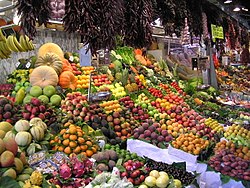GreenC bot (talk | contribs) Rescued 1 archive link; reformat 1 link. Wayback Medic 2.5 |
Citation bot (talk | contribs) Alter: journal. | You can use this bot yourself. Report bugs here. | Suggested by Abductive | Category:Edible fruits | via #UCB_Category |
||
| Line 10: | Line 10: | ||
== Storage == |
== Storage == |
||
Vegetables are optimally stored between 0° and 4.4° Celsius (32° and 40 °F) to reduce [[Respiration (physiology)|respiration]]. Generally, vegetables should be stored at a high humidity (80 and 95 percent relative humidity), but cucurbits (squash family) and onions prefer dry and can mold when moisture is high.<ref>{{Cite journal|last=Fairbanks)|first=Morgan, R. (University of Alaska|date=1991-01-01|title=Vegetable storage in root cellars and basements in Alaska|url=http://www.uaf.edu/files/ces/publications-db/catalog/anr/HGA-00331.pdf|journal=Publication - University of Alaska, |
Vegetables are optimally stored between 0° and 4.4° Celsius (32° and 40 °F) to reduce [[Respiration (physiology)|respiration]]. Generally, vegetables should be stored at a high humidity (80 and 95 percent relative humidity), but cucurbits (squash family) and onions prefer dry and can mold when moisture is high.<ref>{{Cite journal|last=Fairbanks)|first=Morgan, R. (University of Alaska|date=1991-01-01|title=Vegetable storage in root cellars and basements in Alaska|url=http://www.uaf.edu/files/ces/publications-db/catalog/anr/HGA-00331.pdf|journal=Publication - University of Alaska, Cooperative Extension Service (USA)|language=English|volume=|issue=|doi=|pmid=|archive-url=https://web.archive.org/web/20160820055606/http://www.uaf.edu/files/ces/publications-db/catalog/anr/HGA-00331.pdf|archive-date=2016-08-20|access-date=|via=}} [http://agris.fao.org/agris-search/search.do?recordID=US9149943 Alt URL]</ref> |
||
== Bacterial contamination == |
== Bacterial contamination == |
||
Revision as of 04:06, 7 October 2020

Produce is a generalized term for many farm-produced crops, including fruits and vegetables (grains, oats, etc. are also sometimes considered produce). More specifically, the term produce often implies that the products are fresh and generally in the same state as where and when they were harvested.
In supermarkets, the term is also used to refer to the section of the store where fruit and vegetables are kept. Produce is the main product sold by greengrocers (UK, Australia) and farmers' markets. The term is widely and commonly used in the U.S., but is not typically used outside the agricultural sector in other English-speaking countries.
In parts of the world, including the U.S., produce is marked with small stickers bearing price look-up codes. These four- or five-digit codes are a standardized system intended to aid checkout and inventory control at places where produce is sold.
Storage
Vegetables are optimally stored between 0° and 4.4° Celsius (32° and 40 °F) to reduce respiration. Generally, vegetables should be stored at a high humidity (80 and 95 percent relative humidity), but cucurbits (squash family) and onions prefer dry and can mold when moisture is high.[1]
Bacterial contamination
Raw sprouts are among the produce most at risk of bacterial infection.[2]
Rinsing is an effective way to reduce the bacteria count on produce, reducing it to about 10 percent of its previous level.[3]
Wastewater can be a source of contamination, due to contamination of water with fecal matter with salmonella or other bacteria.[4] After Denmark eliminated salmonella in its chickens, attention has turned to vegetables as a source of illness.[4]
See also
Notable people
References
- ^ Fairbanks), Morgan, R. (University of Alaska (1991-01-01). "Vegetable storage in root cellars and basements in Alaska" (PDF). Publication - University of Alaska, Cooperative Extension Service (USA). Archived from the original (PDF) on 2016-08-20.
{{cite journal}}: CS1 maint: multiple names: authors list (link) Alt URL - ^ "Hold the Raw Sprouts, Please". www.medscape.com. Retrieved 2016-09-18.
- ^ DeRusha, Jason (9 November 2010). "Good Question: Does Washing Fruit Do Anything?". Retrieved 2016-09-18.
- ^ a b "No more salmonella in Danish poultry". 3 July 2012. Retrieved 2016-09-18.
Further reading
- Doyle, Martin (1857). Farm & Garden Produce: A Treasury of Information. G. Routledge & Co. OCLC Number: 39049007
- Microbial Safety of Fresh Produce - Google Books
- The Produce Contamination Problem: Causes and Solutions - Google Books
- Produce Degradation: Pathways and Prevention - Google Books
- Decontamination of Fresh and Minimally Processed Produce - Google Books
- Microbiology of Fresh Produce - Google Books
- Slow food: A Passion for Produce - Google Books
- Melissa's Everyday Cooking with Organic Produce - Google Books
- Procurement and Marketing of Minor Forest Produce in Tribal Areas - Google Books
- Public Produce: The New Urban Agriculture - Google Books
- Global standard for food safety: guideline for category 5 fresh produce (North American version) - Google Books